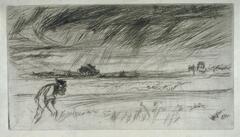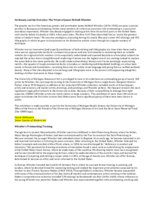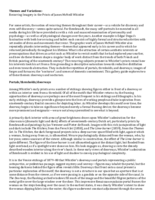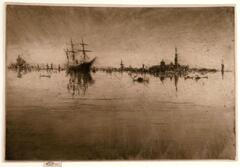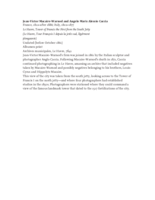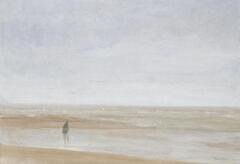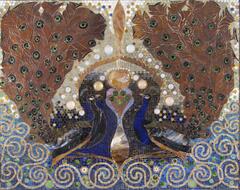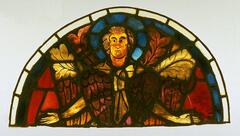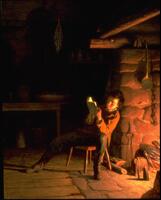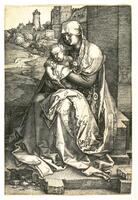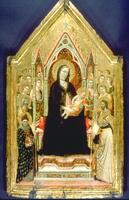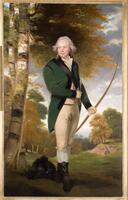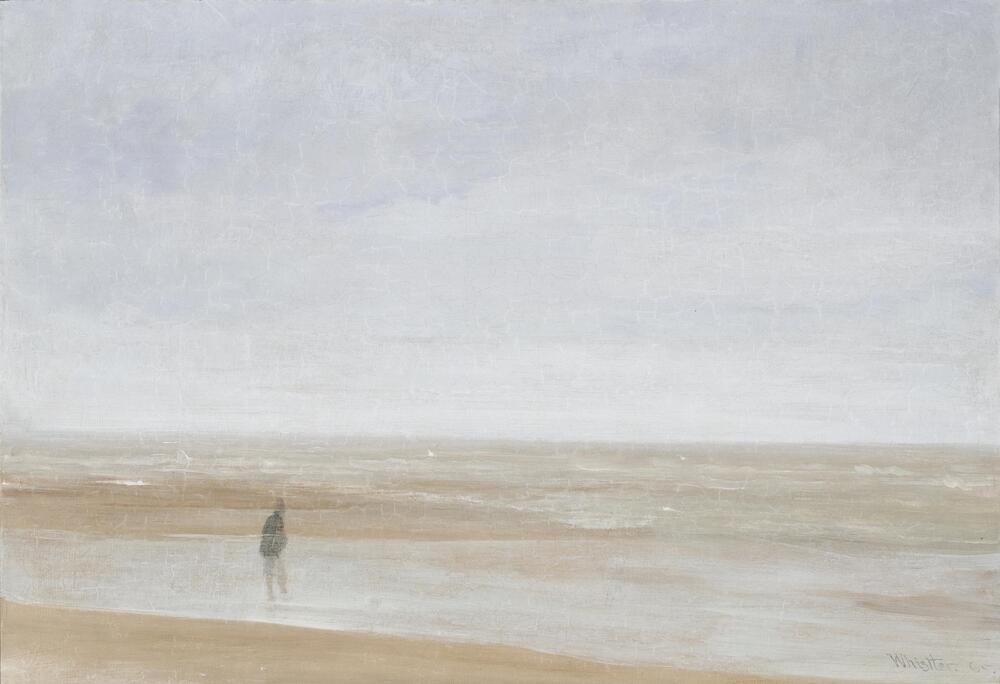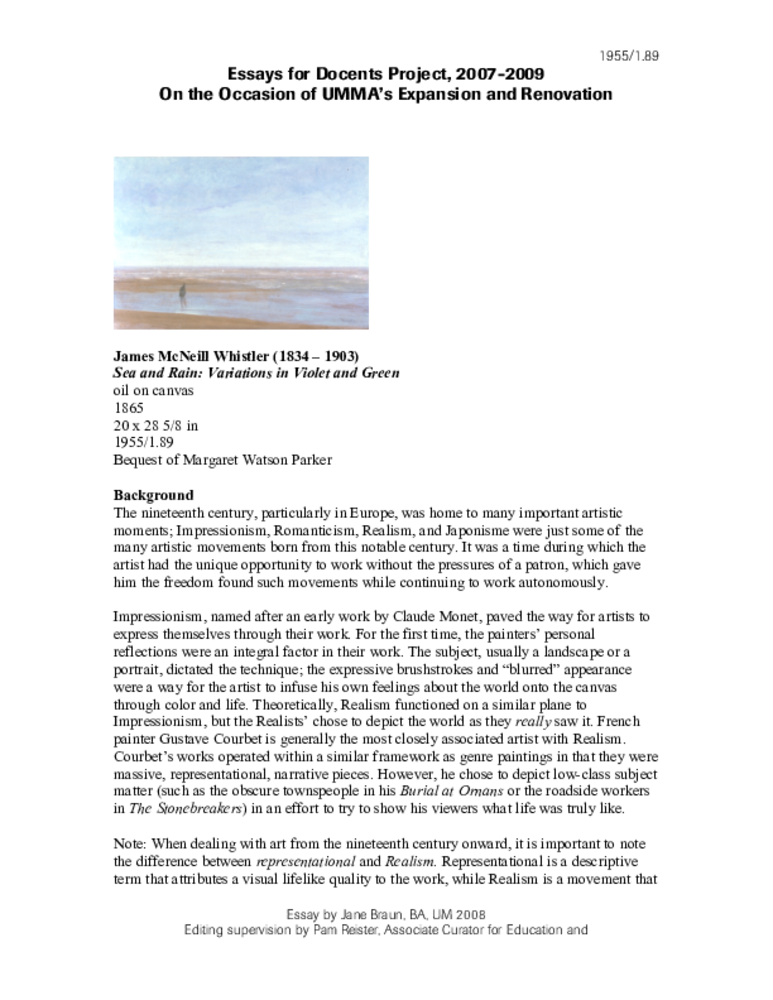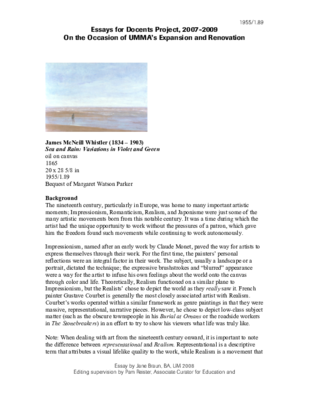Essay: James McNeill Whistler
Background
The nineteenth century, particularly in Europe, was home to many important artistic moments; Impressionism, Romanticism, Realism, and Japonisme were just some of the many artistic movements born from this notable century. It was a time during which the artist had the unique opportunity to work without the pressures of a patron, which gave him the freedom found such movements while continuing to work autonomously.
Impressionism, named after an early work by Claude Monet, paved the way for artists to express themselves through their work. For the first time, the painters’ personal reflections were an integral factor in their work. The subject, usually a landscape or a portrait, dictated the technique; the expressive brushstrokes and “blurred” appearance were a way for the artist to infuse his own feelings about the world onto the canvas through color and life. Theoretically, Realism functioned on a similar plane toImpressionism, but the Realists’ chose to depict the world as they really saw it. French painter Gustave Courbet is generally the most closely associated artist with Realism. Courbet’s works operated within a similar framework as genre paintings in that they were massive, representational, narrative pieces. However, he chose to depict low-class subject matter (such as the obscure townspeople in his Burial at Ornans or the roadside workers in The Stonebreakers) in an effort to try to show his viewers what life was truly like.
Note: When dealing with art from the nineteenth century onward, it is important to note the difference between representational and Realism. Representational is a descriptive term that attributes a visual lifelike quality to the work, while Realism is a movement that aims to represent real life and all of its problems on the canvas. A Realist work is not necessarily representational.
Object Information: Whistler’s Seascape
The stark, ethereal landscape with which Whistler presents his viewer is a clear meditation on mood and color. With his soft, misty brushstrokes, Whistler impresses upon us the overall feeling of dreaminess. Given the year in which it was painted and the artist’s company (fellow artist and famed Realist Gustave Courbet) at the time, it would be fair to say that Sea and Rain is a pensive negotiation between Realism and its softer companion, Impressionism. On the one side, Whistler complies with the Impressionists by allowing the light and form to dictate the way he has applied his paint to the canvas.On the harsher, Realist end of the spectrum, Whistler does not hesitate to leave a lasting message in his work via the solitary figure on a vast expanse of land; the lone, standing figure on the bleak landscape reminds us that we are alone in this modern world.
Technique
Whistler achieved the misty, gray feeling of Sea and Rain by using a number of interesting painting techniques. Firstly, the mood is exponentially enhanced by his limited color palette; according to the University of Michigan Museum of Art publication Eighty Works in the Collection of the University of Michigan Museum of Art, he only used cobalt blue, iron-oxide (a rusty red color), yellow vermilion, and bone black, mixing them with white lead and calcium carbonate. In choosing to work only with primary colors, Whistler ensured that he had total control over the effect his painting would make on viewers. Next, he took care to use large brush strokes in order to create fine,translucent washes of color. Layering one on top of the other, he was able to achieve a bright color while still maintaining the depth of the sky and the ocean. To create the“mist” around the lone figure, Whistler wiped the paint while it was still well, leaving just a veil of the thinnest shade over it.
Artist
James McNeill Whistler was born in 1834 in the United States and left for Europe only twenty-one years later. He lived first in France, but after the failure of his first few major works in oil (for example At the Piano of 1858), he made the decision to go to England,where he remained primarily for the rest of his life. After spending some time in London, Whistler’s failing health inspired a move to the coast to recuperate. He painted Sea and Rain on a particular trip to Trouville (on the coast of Normandy, France), where he spent several weeks painting with famed Realist Gustave Courbet. Courbet would, with his characteristic egotism, later refer to Whistler as his “pupil” when he wrote about that excursion, though he did also acknowledge the influence of impressionism in Whistler’s work in addition to his own.
Whistler’s controlled tonal work in Sea and Rain foretells his later interest in Japanese prints. A treaty signed by Japan and Commodore Perry of England in 1854 for the first time allowed Japanese goods into Europe, including a massive amount of pottery and printwork, to which Whistler probably had access. Whistler’s infatuation with theJapanese stemmed from his admiration of their clean compositions and their limited use of colors; the Japanese artist traditionally depicted only that which was important while using the same color repeatedly to affect a balanced, harmonious final product.
Whistler was and remains one of the most idiosyncratic painters of his time. As an expatriate of the United States who lived and traveled all over Europe, he brought to the table a myriad of experiences and points of view. His painting is known for its refusal tojoin one of the popular “isms” during a time when it seemed that all of painting was being categorized.
Donor
The University of Michigan Museum of art has been fortunate to receive several works of art from Ms. Margaret Watson Parker, many of which are Japanese prints. A native of Vermont, Ms. Parker moved to Evanston, Illinois when she was very young. Her interest in collecting art was evident from her days spent at Northwestern University, where she completed her degree.
Charles Lang Freer, who worked in and around Detroit, was closely associated and an honorary degree holder of the University of Michigan. He was an art dealer who was friends with Whistler; they both shared a love for Asian art. Through another art dealer, Charles J. Morse, Parker became friends with Freer, and he was a heavy influence on the works purchased for her collection up until they mysteriously stopped speaking after a trip to Japan together.
Though Parker was herself a very discerning collector, Freer advised her on many of her acquisitions and probably inspired her interest in Asian art and piqued her interest in Whistler. Her collection consisted of numerous Japanese prints and pieces of pottery as well as several Whistler prints (Sea and Rain was the only Whistler piece she owned done in oil). Her interest in both Japanese art and Whistler speaks to the way the latter was highly influenced by the former.
Themes and Ideas for Teaching
- What does Whistler do in Sea and Rain that distinguishes him from both the Realists and the Impressionists?
- What is the connection between this work and other works donated by MargaretWatson Parker (specifically all of the Japanese pieces she donated)
- How might Whistler’s American background have influenced his work?
Sources
- Cabanne, Pierre, Jennings, Nicolas Max (translator). Whistler. New York, NY: Crown,1985.
- Fleming, Gordon H. James Abbott McNeill Whistler: A Life. New York, NY: Saint Martin’s Press, 1991.
- Eighty Works in the Collection of the University of Michigan Museum of Art: A Handbook. Ann Arbor, Michigan: The University of Michigan, 1979.
- McNamara, Carole, and Siewert, John. Whistler: Prosaic Views, Poetic Vision. Ann Arbor, MI: University of Michigan & Thames and Hudson, Inc., 1994.
- “Whistler, James Abbott McNeill” Grove Art Online. Oxford University Press, 27 October 2007, http://www.groveart.com.
Part of 1 Learning Collection
<p>Exhibition: August 21, 2010 - November 28th, 201...
<p>Exhibition: October 10, 2009 - January 3, 2010</...
1 Link
Created For
K-12 EducatorK-12 Student
Museum Visitor
UMMA Docent
UMMA Staff
University Faculty
University Student
Rate this Resource
AVG: 0 | Ratings: 0
& Author Notes
No copyright restrictions (Authored by Jane Braun (2007))
Last Updated
November 14, 2017 11:03 a.m.Report
Reporting Policy
